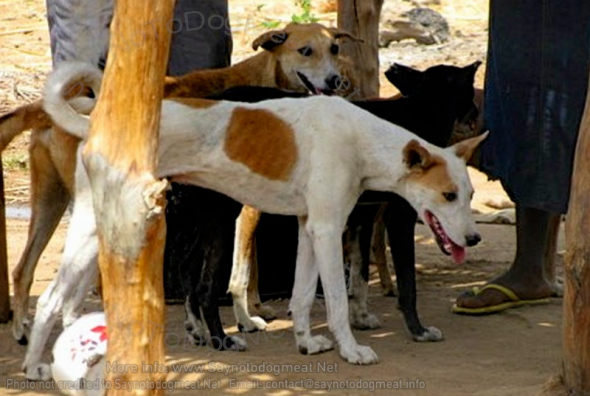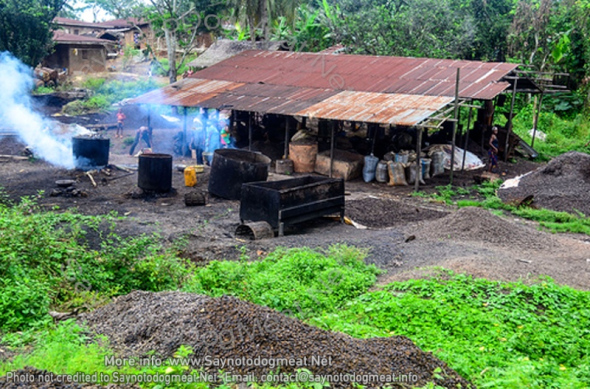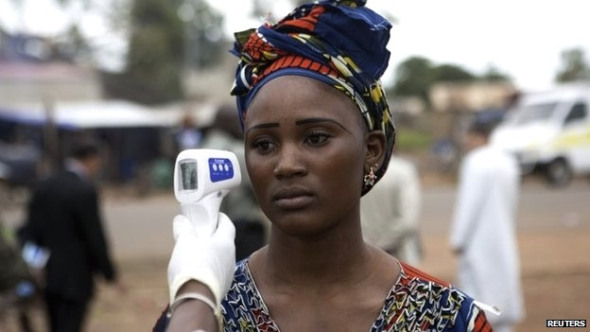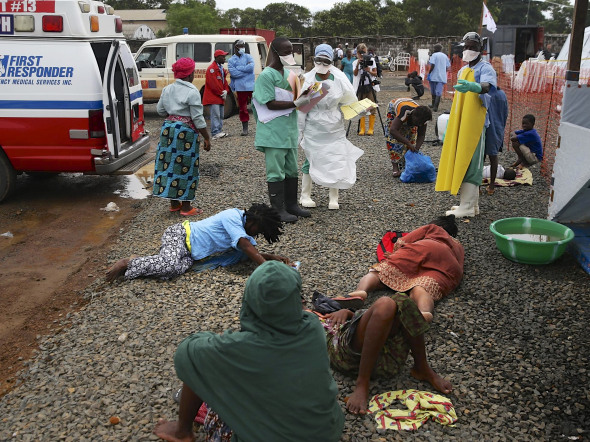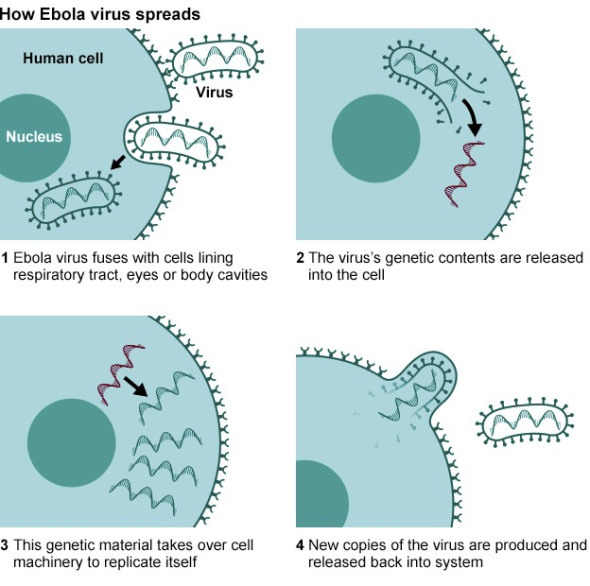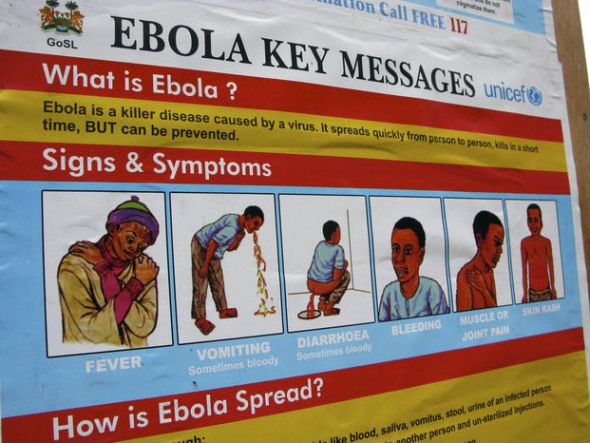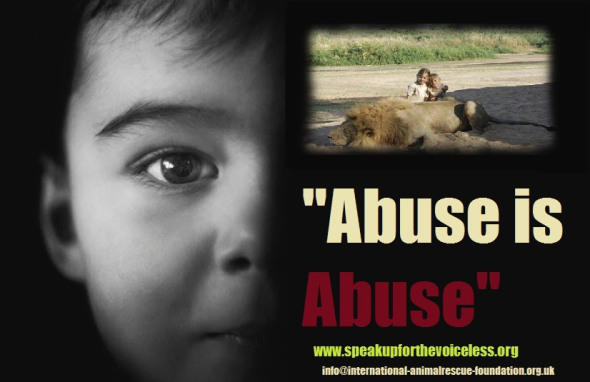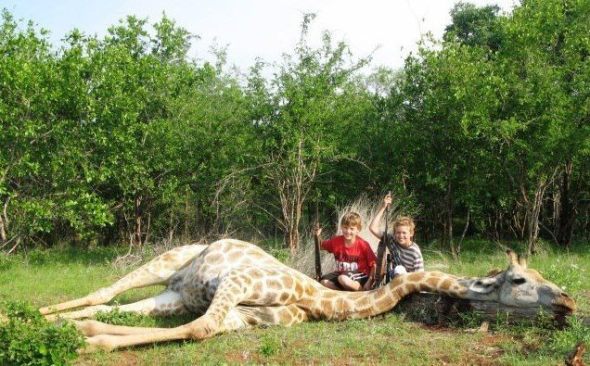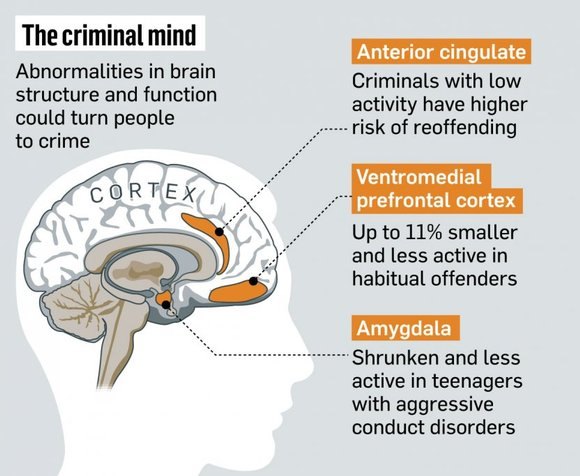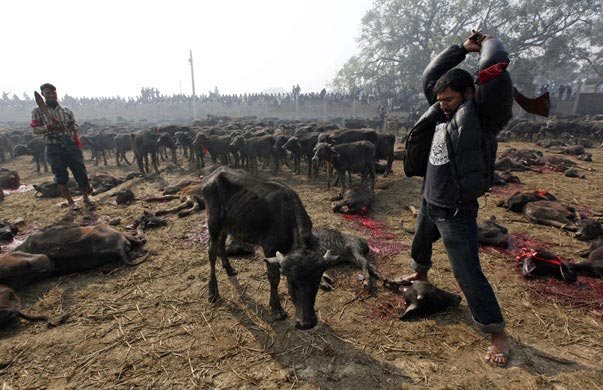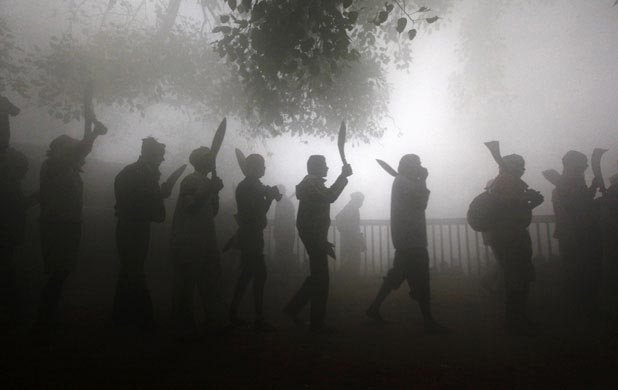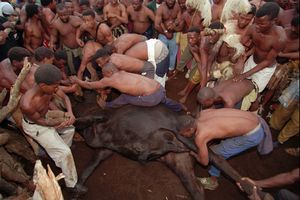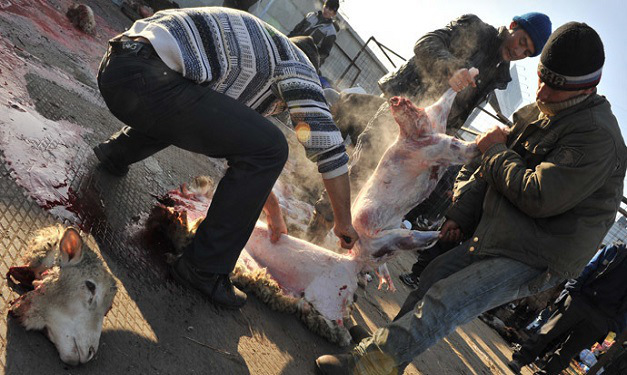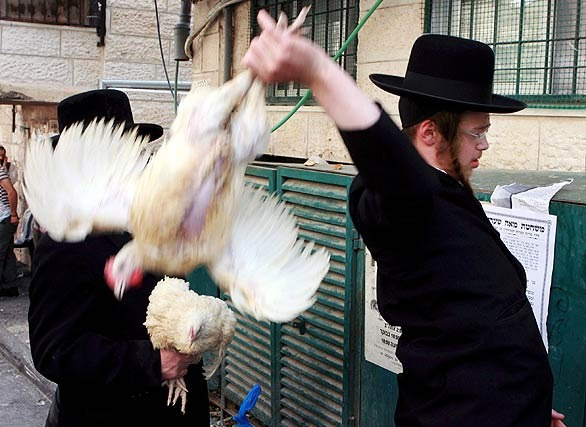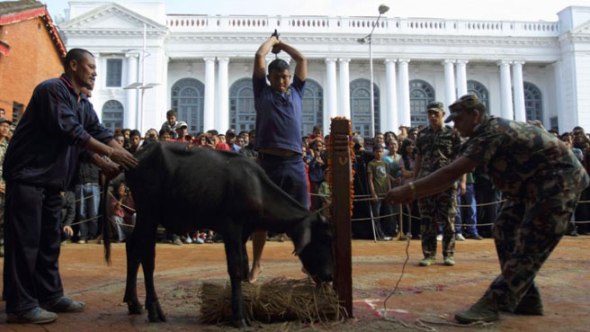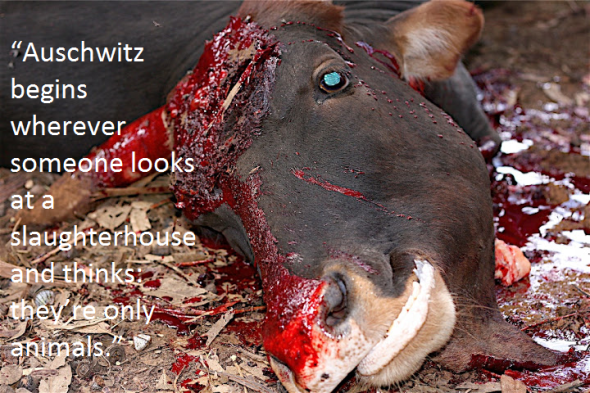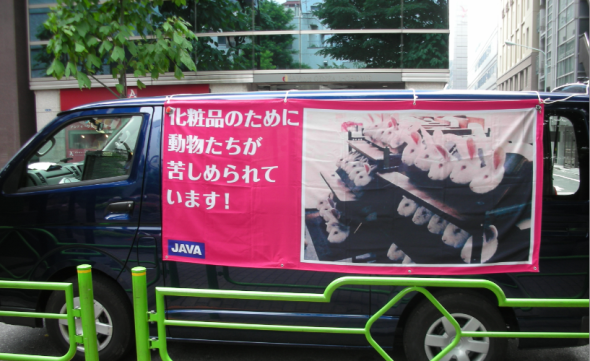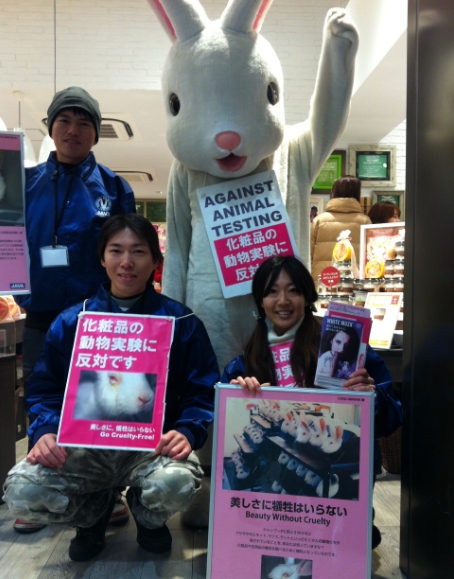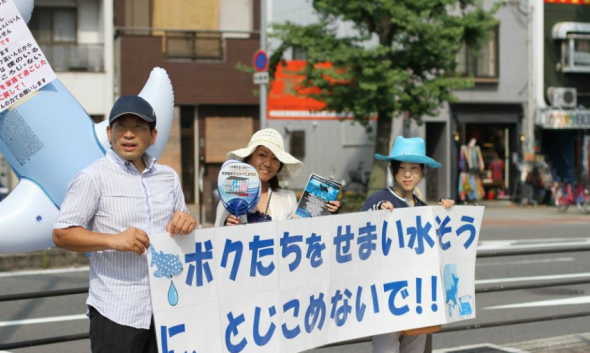Africa: Live Dogs Exchanged For Palm Oil
Danwaki Dog Market is one of the main dog markets in Nigeria where live dogs are bartered in exchange for palm oil. Thursday mornings are the main day, at the Plateau State Dog Market, Danwaki.
On the day before (Wednesday), Kanke dog vendors get their stalls ready to attract as many customers as possible. Most Nigerian markets traders arrive at dawn, but for Danwaki, many traders travel through the night in lorries because by 4.00am the market is already bustling with activity. By 5.00am business is well underway.
Dog traders and buyers travel all the way from states like Cross Rivers, AkwaIbom, Benue, Nasarawa, Taraba, and many other southern states. Dog traders from neighbouring countries of Cameroun and Ivory Coast also frequent this dog market. Traders bring goods from their home states, in exchange for live dogs.
Palm oil from Calabar is known as “red gold,” giving Calabar traders an upper hand in doing business, as they exchange live dogs over for the equivalent value of palm oil.
A regualr dog buyer at Danwaki dog market, Mrs. Bassy Essien says she travels to the dog market twice a month to exchange palm oil for dogs because the business is “lucrative and rewarding,” the only risk involved is having to travel through the night all the way from Calabar to Jos in a lorry.”
She says once she gets the dogs back to Calabar they “sell like hot cakes” because their cooked as delicacies at local hot-beer joints like the Marina Beach spots, where politicians and foreign nationals sit outside in the cool of the evenings and enjoy eating dog meat.
She says:“With dog meat served together with hot local beer, an evening is made in Calabar!”
Another dog trader who calls himself Akpan said: “I have lived all my life in Calabar, but 12 years ago I started my dog business, that I discovered Marina Spot. When I see big politicians enjoy the delicacy dog meat I feel exceedingly fulfilled that I am a part of their joy.”
Dogs are bred in Plateau State for dog meat. [ NOTE: Breeding dogs for consumption means DOG FARMS.]
In Kanke Local Government Area it is considered a great honour to welcome a visitor with dog meat delicacy. Dog meat has now become a trend in most famous “joints,” even in Jos city. People joke that dogs which westerners call “man’s best friend” has now been renamed “man’s best taste.”
Does Dog Meat Have Powers To Cure?
Many people who eat dog meat falsely believe the meat has medicinal properties, including the false belief that dog meat improves a man’s sexual performance. This ties directly in with customers enjoying tough dog meat, which is brought about through cruel methods of slaughter which are done to deliberately flood the dog’s body with as much adrenaline s possible - making the meat as tough as possible. This is falsely believed to enhance a man’s libido. It will NOT.
Dog meat contains no magic, no power and no cures. If you’re impotent then seek professional medical help or see a sex therapist, but do NOT expect to get relief from eating dogs or cats.
Some people believe dog meat cures a lot of disease such as malaria, typhoid, dysentery in children, and even protection against witchcraft. It is falsely believed by some dog meat eaters that if they eat enough dog meat they will be protected from evil. There is no scientific evidence proving dog meat does anything except cure hunger.
Veterinarian Dr. Pam Musa believes dogs are inherently emotional and friendly to humanity and that slaughtering dogs for food is excessively cruel.
Thank you for reading,
Michele Brown.
GLOBAL MARCH
Saturday April 4th, 2015 Saynotodogmeat.Net is hosting a Global March for dogs and cats in the live meat trade. Please march with us, in your country. It will be an orderly and peaceful march but we need more ‘demonstration leaders.’ If you can help us, PLEASE EMAIL: [email protected]
Bring your family, children, pets and banners; we need as many people as possible, worldwide. Please mark your calendar and join our march. If you haven’t already done so, please click the box to let us know you are coming: https://www.facebook.com/events/294347744053559/
WE ARE NOW ACCEPTING DONATIONS
Saynotodogmeat.Net is now accepting donations: PLEASE MARK ALL DONATIONS “SAY NO TO DOG MEAT.NET” https://www.facebook.com/SayNoToDogMeat/app_117708921611213
No donation is too small and we are very appreciative of your help and support. Very soon we will be writing a full article outlining where donations will be used. You will receive an electronic receipt and we will too, which we will keep for historical data purposes. NO DONATION will be used to produce clothing with logos on, badges or banners. Donations are NOT for the directors. ALL MEMBERS FUND THEMSELVES.
PLEASE CONTINUE TO SIGN AND SHARE OUR SAYNOTODOGMEAT.NET PETITIONS; WHEN COMPLETED THEY’LL BE WILL BE HAND DELIVERED
PETITION FOR SOUTH KOREA
https://www.change.org/en-GB/petitions/president-geun-hye-park-take-dog-cat-meat-off-the-menu
PETITION FOR VIETNAM and THAILAND ANTI-SMUGGLING
https://www.causes.com/actions/1764795-a-petition-to-president-truong-tang-sang-moj-prime-minister-yingluck-shinawatra
PETITION FOR HEALTH MINISTER OF VIETNAM
https://www.causes.com/campaigns/71258-minister-of-public-health-thi-kim-tien
PETITION FOR NAGALAND
https://www.change.org/en-GB/petitions/additional-chief-secretary-take-dog-meat-of-nagaland-menu
PETITION TO BAN THE TRADE IN NIGERIA
https://www.change.org/en-GB/petitions/governor-of-lagos-hon-babatunde-fashola-ban-the-nigerian-dog-meat-trade-lagos
LETTER TO THE PRESIDENT OF THE PHILIPPINES
http://saynotodogmeat.net/2014/04/04/email-the-philippines-president-to-end-the-dog-meat-trade/
PLEASE SEND TO THE MUSLIM COUNCIL
http://saynotodogmeat.net/2014/01/17/open-email-to-the-muslim-council-of-great-britain/
PLEASE HELP THE PEOPLE OF TURKANA HERE
http://saynotodogmeat.net/2014/01/31/turkana-africa-emergency-aid-letter/
EMAIL THE GOVERNOR OF NIGERIA: New Address: [email protected]
http://saynotodogmeat.net/2013/12/03/email-excellency-dr-honorable-alausa-excellency-honorable-babatunde-fashola/
JOIN THE WORLDWIDE GLOBAL EVENT HERE TODAY
PLEASE EMAIL US A.S.A.P FOR INFORMATION ON HOW YOU CAN HELP. SATURDAY 4TH APRIL 2015 – TIME TO MARCH FOR DOGS AND CATS IN THE MEAT TRADE.
JOIN HERE https://www.facebook.com/events/294347744053559/ SHARE EVERYWHERE WILDLY
SayNoToDogMeat.Net FACEBOOK and TWITTER
Email: [email protected]
#saynotodogmeat
ALL RIGHTS RESERVED
PLEASE CREDIT THE ORGANISATION WHEN SHARING
Mali, Africa: Dog Meat And Now Ebola
Ebola has now arrived in the country of Mali, West Africa, sparking further panic as the deadly virus creeps across the continent. The patient is a 2-year-old girl who was brought from neighbouring Guinea after her mother died of Ebola.
The girl showed symptoms, including a bleeding nose, while travelling on a public bus through several towns, as she travelled more than 1,000 km (600 miles) from Guinea through the capital, Bamako, to Kayes.
Bamako is a densely-packed city of 2.3 million people.
The girl’s blood sample tested positive in Fousseyni Daou hospital in the western town of Kayes,, where a further 43 people are being quarantined, including 10 health workers. Mali is now the sixth West African country to be fighting Ebola. The World Health Organisation says the disease has infected nearly 10,000 people and killed from half to 70 percent of them.
Dog Meat and Ebola
Dog meat is eaten in Mali and served at many “chop shops.” There is a link between Ebola and dog meat.
Dogs do not show any signs if infected with Ebola and dogs do NOT die from Ebola infections.
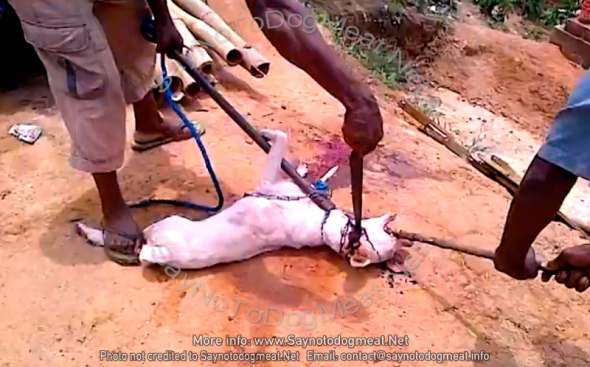
African dog butcher brutally slaughtering a dog for dog meat; the dog was in agony and fully conscious for several minutes.
Saynotodogmeat.Net Director Dr. Josa Depre advises that people refrain from eating dogs within Ebola infected zones. “Consuming dogs within an infected zone and knowing both dog can carry and show no signs is no different to playing Russian Roulette with one’s life,” says Dr. Depre.
Dogs in Africa are typically kept as pets to assist with hunting and are not “fed,” and therefore forced to scavenge food for themselves. In places like Liberia for example, dogs eat the carcass of Ebola infected animals and those same dogs are then captured by dog snatchers and sold for human consumption.
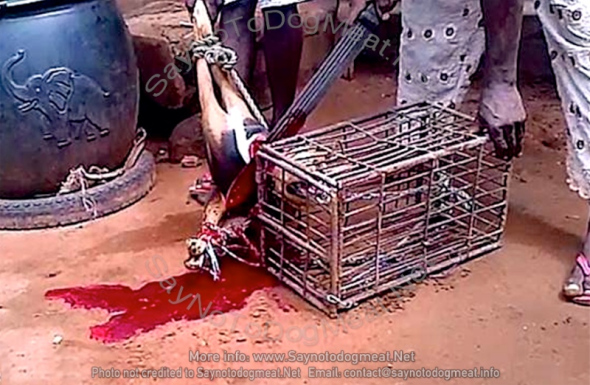
African dog butcher slowly slaughtering a dog, using a panga. Fully conscious, the dog was alive and in great agony for several minutes.
To date there have been no documented infections in felines, meaning that our domestic cats are probably safe from it.
Although dogs are susceptible to Ebola, the CDC concluded that “infected dogs are asymptomatic”, meaning that they do not develop symptoms.
During the early phase of their infection, however, they can spread the disease to humans and other animals through licking, biting, urine, and feces. However, the good news is that once the virus is cleared from the dog it is no longer contagious.”
Chop Shops In Mali
In San, Mali, there’s a restaurant in the old Bamabus terminal at the intersection turning south from the center of town. San is part of the Bobo ethnic area where dog meat is regularly served and eaten “as beef.” Restaurant reviews in Mali suggest that if you do not want to eat dog meat then you should stay away from ALL beef dishes, especially “chop shops” in certain areas, as a lot of the so-called beef is dog meat.
Guinea, which hasn’t closed any of its frontiers with six other nations, shares more than 800km of border with landlocked Mali to the east.
Ebola
Vaccines are not available until the first half of 2015, which is cold comfort for those who need vaccines immediately. Media statements such as “committed to ramping up production” by pharmaceutical companies are hollow words until the vaccines are actually produced and in use.
In America a New York doctor, Dr Craig Spencer who returned from Guinea on October 17th, has tested positive for Ebola, sparking terror amongst Americans after it was announced that the doctor had been travelling on the subway, possibly infecting other people. He is the first Ebola case diagnosed in New York, and the fourth in the US. On Tuesday he began to feel tired and developed a fever and diarrhoea on Thursday (BBC.)
The Ebola fatality rate can reach 90% - but current outbreak has mortality rate of about 70%. Incubation period is two to 21 days and there is no proven vaccine or cure. The current outbreak is the deadliest since Ebola was discovered in 1976.
An international team of scientists has been set up to determine the effectiveness of using the blood of Ebola survivors as a treatment. It is hoped the antibodies used by the immune system to fight Ebola can be transferred from a survivor to a patient.
How Not To Catch Ebola:
* Avoid direct contact with sick patients as the virus is spread through contaminated body fluids
* Wear protective cover for eyes
* Clothing and clinical waste should be incinerated and any medical equipment that needs to be kept should be decontaminated.
* People who recover from Ebola should abstain from sex or use condoms for three months
As with all the other Ebola infected areas, people in Mali are being urged to use soap when washing their hands. It is not customary to do this in Mali, but the World Health Organisation are stressing the importance of it.
All the African countries affected by Ebola are dog eating countries. There is a link between Ebola and dog meat.
DO NOT EAT DOG MEAT!
Thank you for reading,
Michele Brown.
GLOBAL MARCH
Saturday April 4th, 2015 Saynotodogmeat.Net is hosting a Global March for dogs and cats in the live meat trade. Please march with us, in your country. It will be an orderly and peaceful march but we need more ‘demonstration leaders.’ If you can help us, PLEASE EMAIL: [email protected]
Bring your family, children, pets and banners; we need as many people as possible, worldwide. Please mark your calendar and join our march. If you haven’t already done so, please click the box to let us know you are coming: https://www.facebook.com/events/294347744053559/
SAYNOTODOGMEAT.NEt NOW ACCEPTING DONATIONS
Saynotodogmeat.Net is now accepting donations: PLEASE MARK ALL DONATIONS “SAY NO TO DOG MEAT.NET” https://www.facebook.com/SayNoToDogMeat/app_117708921611213
No donation is too small and we are very appreciative of your help and support. Very soon we will be writing a full article outlining where donations will be used. You will receive an electronic receipt and we will too, which we will keep for historical data purposes. NO DONATION will be used to produce clothing with logos on, badges or banners. Donations are NOT for the directors. ALL MEMBERS FUND THEMSELVES.
PLEASE CONTINUE TO SIGN AND SHARE SAYNOTODOGMEAT.NET PETITIONS; WHEN COMPLETED THEY WILL BE HAND DELIVERED
PETITION FOR SOUTH KOREA
https://www.change.org/en-GB/petitions/president-geun-hye-park-take-dog-cat-meat-off-the-menu
PETITION FOR VIETNAM and THAILAND ANTI-SMUGGLING
https://www.causes.com/actions/1764795-a-petition-to-president-truong-tang-sang-moj-prime-minister-yingluck-shinawatra
PETITION FOR HEALTH MINISTER OF VIETNAM
https://www.causes.com/campaigns/71258-minister-of-public-health-thi-kim-tien
PETITION FOR NAGALAND
https://www.change.org/en-GB/petitions/additional-chief-secretary-take-dog-meat-of-nagaland-menu
PETITION TO BAN THE TRADE IN NIGERIA
https://www.change.org/en-GB/petitions/governor-of-lagos-hon-babatunde-fashola-ban-the-nigerian-dog-meat-trade-lagos
LETTER TO THE PRESIDENT OF THE PHILIPPINES
http://saynotodogmeat.net/2014/04/04/email-the-philippines-president-to-end-the-dog-meat-trade/
PLEASE SEND TO THE MUSLIM COUNCIL
http://saynotodogmeat.net/2014/01/17/open-email-to-the-muslim-council-of-great-britain/
PLEASE HELP THE PEOPLE OF TURKANA HERE
http://saynotodogmeat.net/2014/01/31/turkana-africa-emergency-aid-letter/
EMAIL THE GOVERNOR OF NIGERIA: New Address: [email protected]
http://saynotodogmeat.net/2013/12/03/email-excellency-dr-honorable-alausa-excellency-honorable-babatunde-fashola/
JOIN THE WORLDWIDE GLOBAL EVENT HERE TODAY
PLEASE EMAIL US A.S.A.P FOR INFORMATION ON HOW YOU CAN HELP. SATURDAY 4TH APRIL 2015 – TIME TO MARCH FOR DOGS AND CATS IN THE MEAT TRADE.
JOIN HERE https://www.facebook.com/events/294347744053559/ SHARE EVERYWHERE WILDLY
Exposing Children to Violence - Informal Investigation.
Children exposed to any from of violence can enact that violence out onto others which is not uncommon knowledge. Scientists, neurologists, child behavioural experts, psychologists and psychiatrists have all used various forms of analysis that have shown children exposed to “continued” violent acts can then copy their abuser or abuser[s] traits. It must also be noted though, not all children or adults turn out to be abusers of which should never be used in debate.
We wish to make it clear now that this article documents on true factual information based on hunting and exposing children to violence. This article is not in anyway supportive of “responsible hunting or trophy hunting” nor are its authors or organisation[s]. We also wish to state clearly now this article is informal and based on whether any hunting exposure or “human on human violence” can later lead to murder or animal abuse.
This week’s article we focus on “trophy hunting”, “responsible hunting” and “children exposed to violence”. International Animal Rescue Foundation Africa has since 2011 been lobbying all African country ministries to implement restrictions and/or bans on trophy hunting for various reasons listed below;
- Hunting blocks purchased by hunting organisations reduces land mass for “wild animals”.
- Trophy hunting has been linked directly to poaching of which evidence has clearly shown many hunters dabbling in the black market wildlife trade.
- Sport hunting is linked to serious declines of many African and non-African native species decline as stated in various on-line journals written by ourselves, non-related wildlife organisations and the IUCN.
- Child abuse - sport hunting and “responsible hunting”. Children exposed directly to uncontrolled sport hunting have shown more “abusive traits” and mental illnesses compared to those that are taught “responsible hunting”. However this article should not in any way be used as debate to prove that “any hunting” can later lead to children killing. Concluding we have clearly shown that “exposing children to ANY violence can directly lead to more narcissistic and/or psychopathic violent behaviours.
Today we focus on sport hunting, trophy hunting and “abuse”.
- Sustainability of hunting means that the use of these natural resources must be assured not only in the present but also to future generations.
- Trophy hunting is the selective hunting of wild game animals. Although parts of the slain animal may be kept as a hunting trophy or memorial (usually the skin, antlers and/or head), the carcass itself is sometimes used as food.
-
Abuse can be noted as cruel and violent treatment of a person or animal that can lead to the “abused” then showing direct similar traits carried on from their “abuser[s]” of abuse to others late on in life.
International Animal Rescue Foundation Africa welfare experts are become increasingly concerned with regards to the increased exposure of sport hunting to minors within South Africa, Namibia and Zimbabwe. Pictures and videos of children as young as “seven” years old have emerged on-line and off depicting them sat with a sport hunted lion, giraffe, elephant, leopards and even crocodiles being some of the most commonly seen photographs. Our concerns are with regards to minors being exposed to such violent acts of animal killing whilst child is still within the developing stage and not fully understanding rights and wrongs from piers.
Please note this article does not change our perspective on “trophy hunting or responsible hunting.
Sport/Trophy Hunting -
Trophy hunting is the selective hunting of wild game animals. Although parts of the slain animal may be kept as a hunting trophy or memorial (usually the skin, antlers and/or head), the carcass itself is sometimes used as food. Trophy hunting has firm supporters and opponents. Public debate about trophy hunting often centres on the question of the morality of sport hunting and the question of the extent to which the money paid by trophy hunters benefits the population of game animals and the local economy. Trophy hunting should not be confused with poaching, the practice of taking game illegally.
Educative responsible hunting -
- Safe - bottom line you must follow the safety rules for gun handling and hunting. If you endanger yourself, others or property you are not a responsible hunter.
- Lawful - Game laws can be complicated and tempting to bend or break. But they have a vital purpose and must be followed to the letter and spirit.
- Clean Kill - Responsible hunters only shoot at game they know they can kill, not to see if they can hit it. Accidents happen, but we do everything we can to make one-shot kills. Excuses like I didn’t have time to sight in, or practice or check my pattern are just not tolerable by “responsible hunters”.
- Full Utilization - If you kill it you eat it. If you don’t like mergansers and don’t know anyone who does - don’t shoot them. For game like moose it takes planning ahead to be sure you can get it out of the woods and cool it down before it spoils, not as easy as you might think. The exception to this rule is damage or cull shooting. But that is different than hunting and I still think the critter should be used if at all possible, even if it is just cleaning the coyote skull for the local Boy Scout troop.
- Fair Chase - If it is a 100% guaranteed kill or the animal can’t get away it is not an ethical hunt. The outcome of the hunt must be in doubt up to the second the trigger is pulled. Anything else is just shooting or slaughtering. Within this definition is lots of room and it will vary between hunters and even the same hunter. There is inherent conflict between fair chase and clean kill. If you erect to high a barrier to harvest, say using a homemade stick bow, you could, without a lot of discipline, set your self up for wounding animals because your skill level is not high enough to be successful under reasonable conditions.
- Support Conservation - This applies primarily to more experienced hunters. I don’t think you can call yourself a responsible hunter unless you are actively supporting wildlife conservation beyond buying licenses and paying tax on equipment and ammo. We need to be in the arena supporting scientific management and environmentally sound policies- politically, physically and monetarily. I also don’t think paying dues to a hunting club or conservation organization is enough. It is a great start but not enough. We need to be actively engaged with that club, doing things like habitat work on the ground and making those phone calls to legislators.
As one can clearly see trophy hunting and responsible hunting are not in any way shape or form the same. The only identical similarities are that of killing, harvesting and permits. Whilst we are completely against all hunting it must be noted that there is by far more control within “responsible hunting” and that of “trophy hunting”.. Responsible hunters educate their children on “killing humanely, quick kills, slaughter and preparation, ensuring wildlife disruption” is kept to a bare minimal. The trophy/sport hunter does not “kill for the meat, lacks education on the animal[s] they are to shoot, many are very poor hunters with hardly any firearms training, funding generated within the trophy hunting business rarely supports wildlife preservation. Our own evidence plus that of law enforcements clearly shows that an educated hunter is less likely to commit violent crime to an animal. However it must be made clear now that regardless of whether the child has been educated on the rights and wrongs of animal killing the fact stands at this; Any child exposed to any form of violence is more susceptible to become abusive or to enact violent crime[s]/anti social behaviour.
Brain development and exposure to violence;
At birth, the human brain is undeveloped. Not all of the brain’s areas are organized and fully functional. It is during childhood that the brain matures and the whole set of brain-related capabilities develop in a sequential fashion. We crawl before we walk, we babble before we talk. The development of the brain during infancy and childhood follows the bottom-up structure. The most regulatory, bottom regions of the brain develop first; followed, in sequence, by adjacent but higher, more complex regions.
The process of sequential development of the brain and, of course, the sequential development of function, is guided by experience. The brain develops and modifies itself in response to experience. Neurons and neuronal connections (synapses) change in an activity-dependent fashion. This “use-dependent” development is the key to understanding the impact of neglect, exposure to violence and trauma on children.
These areas organize during development and change in the mature brain in a “use-dependent” fashion. The more a certain neural system is activated, the more it will “build-in” this neural state: what occurs in this process is the creation of an “internal representation” of the experience corresponding to the neural activation. This “use-dependent” capacity to make an “internal representation” of the external or internal world is the basis for learning and memory. The simple and unavoidable result of this sequential neurodevelopment is that the organizing, “sensitive” brain of an infant or young child is more malleable to experience than a mature brain.
While experience may alter and change the functioning of an adult, experience literally provides the organizing framework for an infant and child. The brain is most plastic (receptive to environmental input) in early childhood. The consequence of sequential development is that as different regions are organizing, they require specific kinds of experience targeting the region’s specific function (e.g., visual input while the visual system is organizing) in order to develop normally. These times during development are called critical or sensitive periods. Whilst these times are developing, exposure to environmental abuse, animal abuse or both can alter the way in which the child brain later functions in life. (E.g) exposing a child within the developing times acts of animal slaughter and abuse can lead the child to believe that what their pier/parent or sibling is enacting is completely normal behaviour. After all child is “developing” and will not know right from wrong. Another concern raised is when the child’s brain is fully developed between the ages of 20-25. Prolonged exposure “violent acts” is again seen as normal of which crime then becomes a concern.
With optimal experiences, the brain develops healthy, flexible and diverse capabilities. When there is disruption of the timing, intensity, quality or quantity of normal developmental experiences, however, there may be devastating impact on neurodevelopment — and, thereby, function. For millions of abused and neglected children, the nature of their experiences adversely influences the development of their brains. During the traumatic experience, these children’s brains are in a state of fear-related activation. This activation of key neural systems in the brain leads to adaptive changes in emotional, behavioral and cognitive functioning to promote survival. Yet, persisting or chronic activation of this adaptive fear response can result in the maladaptive persistence of a fear state. This activation causes hypervigilance, increased muscle tone, a focus on threat-related cues (typically non-verbal), anxiety, behavioral impulsivity — all of which are adaptive during a threatening event yet become maladaptive when the immediate threat has passed.
This is the dilemma that traumatic abuse brings to the child’s developing brain. The very process of using the proper adaptive neural response during a threat will also be the process that underlies the neural pathology, which causes so much distress and pain through the child’s life. The chronically traumatized child will develop a host of physical signs (e.g., altered cardiovascular regulation) and symptoms (e.g., attentional, sleep and mood problems) which make their lives difficult.
There is hope, however. The brain is very “plastic” — meaning it is capable of changing in response to experiences, especially repetitive and patterned experiences. Furthermore, the brain is most plastic during early childhood. Aggressive early identification and intervention with abused and neglected children has the capacity to modify and influence development in many positive ways.
The elements of successful intervention must be guided by the core principles of brain development. The brain changes in a use-dependent fashion. Therapeutic interventions that restore a sense of safety and control are very important for the acutely traumatized child. In cases of chronic abuse and neglect, however, the very act of intervening can contribute to the child’s catalogue of fearful situation. Investigation, court, removal, placement, re-location, and re-unification all contribute to the unknown, uncontrollable and, often, frightening experiences of the abused child. Our systems, placements and therapeutic activities can diminish the fearful nature of these children’s lives by providing consistency, repetition (familiarity), nurturance, predictability and control (returned to the child). Yet the poorly coordinated, over-burdened and reactive systems mandated to help these children rarely can provide those key elements.
Hunting;
Surveys conducted over a period of five years by ourselves and third parties have shown that responsible hunters that teach their children to hunt are less likely to see their children enact violence onto others. The responsible hunter will during the process of educating their child ensure child is tutored correctly, understands the correct protocol of humane quick kill, importance of killing, preparing and feeding family all meat from the slaughtered animal. Father and/or mother will teach child that what is taken from the land must be given back, to aid conservation to ensure that no animal that they kill is “left suffering”. Whilst we are totally against hunting it must be noted that whilst the teacher is constantly with their child teaching wrongs from rights abuse in the later years is kept to a bare minimal. This “type” hunting may reduce future abuse because father and mother has “educated” their child. There is little education within the trophy hunting sector and as explained many animals are left to suffer from inexperienced hunters that can barely hold or shoot a rifle professionally.
Occasionally we view and hear debates with regards to hunters turning out to be abusers or even killers based on the fact their mother, father or family relative have taught them to kill animals. There are also cases where many people have stated if you have been abused as a child whether it be exposure to abuse or physical abuse you’ll later on turn out to become an abuser. We would like to dispel this theory as its not entirely factual. Not all children or adults even exposed to violence then become an abuser. Cognitive therapy, counselling or medication has helped to alive-ate many children and young adults exposed to violence within their early years. In many cases some children are not even affected by such violent exposure however it must be noted that the “victim” will never entirely forget their past.
Below is the story of a man that was never exposed to “any hunting” - he taught himself. Please do note though the “early abuses” inflicted down to him of which he was bullied at school and didn’t have an entirely good relationship with his father. Hansen later went on a killing spree hunting his victims down in the same way a trophy hunter or responsible hunter would stalk and kill an animal.
Robert Hansen;
A.K.A.: “The Alaska’s Serial Killer”
Classification: Serial killer
Characteristics: Rape - Flew his victims into the Alaskan wilderness and hunted them down like wild game
Number of victims: 17 - 21
Date of murders: 1973 - 1983
Date of arrest: June 1983
Date of birth: February 15, 1939
Victims profile: Women (prostitutes, topless dancers, or topless barmaids)
Method of murder: Shooting (.223-caliber Ruger Mini-14 rifle)
Location: Anchorage, Alaska, USA
Status: Sentenced to a term of life imprisonment plus 461 years on February 28, 1984
Hansen was married in 1961 and divorced within the year, following his first arrest, on charges of arson. Six years later, he wed another Pocahontas native and she followed him to Anchorage, Alaska, where he opened his own bakery and prospered in a new land, safely removed from the painful memories of childhood and adolescence. Hansen took flying lessons and purchased his own private plane, earning a reputation as an outdoors man and hunter who stalked Dahl sheep, wolves, and bear with a rifle or bow and arrow.
In 1972, Hansen was arrested twice more, charged with the abduction and attempted rape of a housewife (who escaped his clutches) and the rape of a prostitute (who did not). Serving less than six months on a reduced charge, he was picked up again, for shoplifting a chain saw, in 1976. Convicted of larceny, he was sentenced to five years in prison, but the verdict was overturned on appeal, the Alaska Supreme Court regarding his sentence as “too harsh.”
Unknown to local authorities, Hansen’s visible activities were only the tip of a very lethal iceberg. According to his subsequent confession, Hansen preyed consistently on women in the decade between 1973 and 1983, murdering 17 and raping another 30 who survived.
As targets, he selected prostitutes, “exotic” dancers and the like, abducting them by airplane to the wilderness outside of Anchorage, where they were forced to act out Hansen’s private fantasies. “If they came across with what I wanted,” he explained, “we’d come back to town. I’d tell them if they made any trouble for me, I had connections and would have them put in jail for being prostitutes.” Resistance — or demands for payment after sex — resulted in assorted victims being murdered, sometimes with the ghoulish touch of Hansen stripping them and stalking them like animals, making the kill with a hunting knife or his favorite big-game rifle.
The first indication of a killer at large came in 1980, when construction workers unearthed a woman’s remains near Eklutna Road. Stabbed to death in 1979, she was never identified, dubbed “Eklutna Annie” by police assigned to work the case. Later that year, the corpse of Joanna Messina was found in a gravel pit near Seward, and a special task force was organized to probe the killings. Topless dancer Sherry Morrow had been dead ten months when hunters found her body in a shallow grave beside the Knik River, but the discovery brought authorities no closer to a solution in their case.
In 1983, Hansen decided to save time and energy by bringing his victims home. He called it his “summer project,” laying the groundwork by packing his wife and two children off on a European vacation. Next, he began running ads in a local singles newspaper, seeking women to “join me in finding what’s around the next bend, over the next hill.”
On June 13, 1983, a 17-year-old captive escaped from Hansen en route to his airplane hangar, handcuffs still dangling from one wrist as she ran for help. Her charges brought Hansen to the attention of task force detectives, and he ultimately confessed to a series of 17 murders, including that of Paula Golding, found by hunters in September 1983.
On a flying tour of the wilderness, Hansen began pointing out graves to state troopers, and they recovered eleven bodies over the next eight months. Several victims remained anonymous, their names unknown even to Hansen, but others were identified as Rox Easland, Lisa Futrell, Andera Altiery, Angela Fetter, Tersa Watson, and Delynn Frey — all reported missing from the Anchorage area during Hansen’s reign of terror.
On February 18, 1984, Robert Hansen pled guilty on four counts of first-degree murder, in the cases of “Eklutna Annie,” Joanna Messina, Sherry Morrow, and Paula Golding. Charges were dismissed in the other cases, but it scarcely mattered, as Hansen was sentenced to-a term of life imprisonment plus 461 years.
Michael Newton - An Encyclopedia of Modern Serial Killers - Hunting Humans..
Case study - Abused child turns into a serial killer - Exposing children to violence whether it be hunting, human on human abuse has now led experts to conclude that no matter what the “type” of violence or exposure to violence is inflicted can seriously affect a child’s thinking and thought process later on in life. Many crimes committed by young men and women have been carried out by both sexes just after complete brain maturity.
This case is rather interesting as it depicts many traits that have been explained within our own past journals and that of others. The young Richard Trenton Chase was a healthy child when born that showed no signs of mental illness or wanting to maim animals or humans. However as Richard developed on into childhood his father an abusive man dished out strict punishment for the most petty of things. Please read more below.
A.K.A.: “The Vampire of Sacramento”
Classification: Spree killer
Characteristics: Mental illness - Necrophilia - Cannibalism - Mutilation
Number of victims: 6
Date of murders: December 1977 - January 1978
Date of arrest: January 1978
Date of birth: May 23, 1950
Victims profile: Ambrose Griffin, a 51 / Teresa Wallin, 22 (three months pregnant) / Evelyn Miroth, 38; her son, Jason, 6; her nephew, David, 22-month-old; and her friend, Dan Meredith, 51
Method of murder: Shooting (.22 handgun)
Location: Sacramento, California, USA
Status: Sentenced to death on May 8, 1979. Committed suicide with an overdose of prison doctor-prescribed antidepressants that he had been saving up for the last few weeks on December 26, 1980
Richard Trenton Chase (May 23, 1950 – December 26, 1980) was an American serial killer who killed six people in the span of a month in California. He earned the nickname The Vampire of Sacramento because he drank the blood of his victims and ate their internal organs. He did this as part of a delusion that he needed to prevent Nazis from turning his blood into powder via poison they had planted beneath his soap dish.
Early years/first signs of mental illness
Born in 1950, he was raised in a strict household and was beaten often by his father. In his teens he became an alcoholic and also developed a penchant for killing and mutilating animals and firestarting, all common traits amongst serial killers in their youth.
In high school, Chase had a handful of girlfriends, none of whom he was able to maintain a steady relationship with, partly due to his inability to achieve or maintain an erection, and because of an inability to become aroused in the presence of females. Upon consulting a psychiatrist, Chase was told that the root of his problems was either repressed rage or mental illness. Chase did not seek any further treatment after this diagnosis; it would later be determined that Chase had an aversion to conventional sex and could only achieve arousal and orgasm through violent or disturbed acts, such as killing animals and necrophilia.
Early adulthood
As an adult, Chase moved back in with his mother, where he began to accuse her of attempting to murder him via poison. Chase’s father purchased an apartment for him and forced him to move out of the house.
Alone in his new apartment, Chase began to capture, kill, and disembowel various animals, which he would then devour raw. He then began to put the entrails of the animals he had killed into a blender in order to make smoothies. Chase reasoned that by drinking these smoothies he was preventing his heart from shrinking; he feared that if it shrank too much it would disappear and then he would die.
Institutionalization
In 1975, Chase was involuntarily committed to a mental institution after being taken to a hospital for blood poisoning, which he contracted after injecting rabbit’s blood into his veins
Chase escaped from the hospital and went home to his mother; he was apprehended and sent to an institution for the criminally insane, where he often shared with the staff fantasies about killing rabbits. He was once found with blood smeared around his mouth; hospital staff discovered that he had captured two birds through the bars on his bedroom windows, snapped their necks, and sucked their blood out. Among themselves, the staff began referring to him as “Dracula.”
After undergoing a battery of treatments involving psychotropic drugs, Chase was deemed no longer a danger to society, and in 1976, he was released into the recognizance of his parents; his mother, deciding that her son did not need to be on the antischizophrenic medication that he had been prescribed, weaned him off it.
Post-institutionalization/worsening behavior
His parents put him up in an apartment, where he began to capture, torture to death, and then drink the blood of rabbits, dogs, and cats; on occasion, he killed and ate neighbor’s pets, and at least once contacted the neighbor by telephone to explain what he had done. At the same time, he developed a fascination for firearms and purchased several handguns, with which he practiced obsessively. He became fascinated by the crimes of the Hillside Strangler; he believed the Strangler was also the victim of the Nazi/UFO conspiracy that he believed he was the victim of.
Chase also began to lose interest in caring for himself; he neglected personal hygiene such as bathing, grooming, and brushing his teeth. He stopped eating and dropped to the fairly meager weight of 145 lb.
One day in 1977, Chase rang his mother’s doorbell and greeted her by thrusting a dead cat in her face. He then threw the cat to the ground, knelt down, ripped its stomach open with his bare hands, and stuck his hands inside the cat, smearing its blood all over his face while screaming. His mother calmly returned inside the house and did not report the incident to anyone.
On August 3, 1977, Nevada state police discovered Chase’s Ford Ranchero lodged in a sand drift near Pyramid Lake, Nevada; inside were two rifles, a pile of clothes, a bucket full of blood and a cow’s liver. The officers tracked down Chase, who was naked and screaming in the sand, soaked from head to toe in blood. When questioned, he claimed that the blood was his own, and that it had leaked out of him through his flesh.
On December 27, 1977, Chase fired a .22 handgun into the home of a Sacramento woman. A police search of the woman’s home found the slug in her kitchen; no one was harmed.
The first murder
On December 29, 1977, Chase killed his first victim in a drive-by shooting, in an apparent “warm up” for the crimes he planned on committing. The victim was Ambrose Griffin, a 51-year-old engineer and father of two, who was helping his wife bring groceries into their home. One of Griffin’s sons reported seeing a neighbor walking around their East Sacramento neighborhood with a .22 rifle earlier that week; the neighbor’s rifle was seized, but ballistics tests determined that it was not the murder weapon; however, it was determined that the .22 used to kill Ambrose Griffin was the same one used to fire the bullet into the kitchen of the Sacramento woman two days before.
The second murder
On January 11, 1978, Chase asked his neighbor for a cigarette and then forcibly restrained her until she gave him an entire pack.
Two weeks later, he attempted to enter the home of another woman but, finding that her doors were locked, went into her backyard and walked away; Chase later told detectives that he took locked doors as a sign that he was not welcome, but that unlocked doors were an invitation to come inside. While wandering around, he encountered a girl named Nancy Holden, with whom he attended high school. He attempted to get a ride from her, but frightened by his appearance, she refused.
He went down the street where he broke into the home of a young married couple, stole some of their valuables, urinated into a drawer of their infant’s clothing, and defecated on their son’s bed. The couple came home while Chase was still in the house; the husband attacked him, but Chase escaped.
Chase continued to attempt to enter homes until he came across the home of David and Teresa Wallin. David was at work; Teresa, three months pregnant, was in the middle of taking out the garbage and thus had left her front door unlocked. Chase surprised her in the home and shot her three times, once in the hand (a defensive wound) and twice in the head, killing her; it was the same gun used to kill Ambrose Griffin.
Chase then dragged her body to her bedroom and raped it post-mortem while repeatedly stabbing it with a butcher knife. When he had finished, he carved the corpse open and removed several of her internal organs, using a bucket to collect the blood and then taking it in the bathroom to bathe in it. He then sliced off her nipple and drank her blood, using an empty yogurt container as a drinking glass; before leaving, he went into the yard, found a pile of dog feces, and returned to stuff it into the corpse’s mouth and throat.
The third murder/mass murder
On January 23, 1978, two days after killing Teresa Wallin, Chase purchased two puppies from a neighbor, which he then killed and drank the blood of, leaving the bodies on the neighbor’s front lawn.
On January 27, Chase committed his final murder, which also qualifies as a mass murder. He entered the home of 38-year-old Evelyn Miroth, who was babysitting her 22-month-old nephew, David; also present in the home was Eveyln’s six-year-old son Jason, and Dan Meredith, a neighbor who had come over to check on Evelyn. Evelyn was in the bath while Dan watched the children; he went into the front hallway when Chase entered the home, and was shot in the head at point-blank range with Chase’s .22 handgun, killing him (again, this was the same gun used in the Griffin and Wallin murders).
Chase then turned the corpse over and stole Dan’s wallet and car keys. Jason ran to his mother’s bedroom, where Chase fatally shot him twice in the head at point-blank range; on the way to killing Jason, Chase also shot David in the head.
Chase then entered the bathroom and fatally shot Evelyn once in the head. He dragged her corpse onto the bed, where he simultaneously sodomized it and drank its blood from a series of slices to the back of the neck. Medical examiners reported an inordinate amount of semen in the corpse’s rectum, indicating an “unusual amount” of ejaculations.
When Chase had finished, he stabbed her “at least half a dozen times” in the anus, the knife penetrating her uterus. He stabbed her in a series of vital points on the body, which caused blood from her internal organs to pool into her abdomen, which he then sliced open and drained into a bucket; he then consumed all of the blood. Chase then went to retrieve David’s corpse; he took it to the bathroom and split its skull open in the bathtub, and consumed some of the brain matter.
Outside, a six-year-old girl with whom Jason Miroth had a playdate knocked on the door, startling Chase; he fled the residence, stealing Dan Meredith’s car; the girl alerted a neighbor. The neighbor broke into the Miroth home where he discovered the bodies and contacted the authorities. Upon entering the home, police discovered that Chase had left perfect handprints and perfect imprints of the soles of his shoes in Evelyn’s blood.
Chase, meanwhile, took David’s corpse home with him, where he chopped off his penis and used it as a straw through which he sucked the blood out of the body. He then sliced the corpse open and consumed several internal organs and made smoothies out of others, finally disposing of the corpse at a nearby church.
Exposing violence to children within the “developing times” can lead to deep emotional trauma. Whether it be trophy hunting, responsible hunting or just human on human abuse. Criminology reports have shown that children whom are “taught” rights from wrongs are less likely to pursue criminal activities themselves. Evidence clearly shows although “small” that good parenting decreases adolescent violent tendencies.
Acts of cruelty to animals are not mere indications of a minor personality flaw in the abuser; they are symptomatic of a deep mental disturbance. Research in psychology and criminology shows that people who commit acts of cruelty to animals don’t stop there—many of them move on to their fellow humans. “Murderers … very often start out by killing and torturing animals as kids,” says Robert K. Ressler, who developed profiles of serial killers for the Federal Bureau of Investigation (FBI).
Studies have shown that violent and aggressive criminals are more likely to have abused animals as children than criminals who are considered non-aggressive. A survey of psychiatric patients who had repeatedly tortured dogs and cats found that all of them had high levels of aggression toward people as well. According to a New South Wales newspaper, a police study in Australia revealed that “100 percent of sexual homicide offenders examined had a history of animal cruelty.” To researchers, a fascination with cruelty to animals is a red flag in the backgrounds of serial killers and rapists. According to the FBI’s Ressler, “These are the kids who never learned it’s wrong to poke out a puppy’s eyes.”
Concluding;
These are the kids who never learned its wrong to poke out a puppy’s eyes. So is it correct to state that children whom are taught “responsible hunting” are less likely to kill or abuse other living beings? Based on surveys and other third party information we have shown that responsible hunters are less likely to abuse, what if though them responsible hunters were physically and emotionally abused by their parents or other family members/friends?. Based on criminology reports and forensic adolescent psychiatry its quite evident that regardless of whether you’ve been educated on how to kill animals responsibly or humanely or have little or no educating in hunting whatsoever there is little evidence to actually conclude that responsible hunters are less likely to abuse than those of “trophy hunters”. The real issue here is when a child is exposed to ANY form of abuse within the developing stages of mental maturity. Abuse is abuse no matter how much you sugar coat it, make it look like education its abuse full stop. And whilst our children are within the developing stages of mental maturity it would deeded as “abusive” to educate your child on animal killing whether it be for sport or sustainably. Children learn from a young age fast, they pick up very bad habits from their piers. Just because child is not showing no signs of mental disorders or conduct disorder doesn’t mean for one minute that the child you educated to kill an animal hasn’t been deeply traumatised, and that is a FACT.
Thank you taking the time to read this informal article;
Author - Dr Josa C. Depre
International Animal Rescue Foundation
Auschwitz begins wherever someone looks at a slaughterhouse and thinks: they’re only animals.
“Could a being create the fifty billion galaxies, each with two hundred billion stars, then rejoice in the smell of burning goat flesh?”
Sacrificial animal slaughter for religious reasons and beliefs is cruel and barbarically outdated. Back in 2012 in Sri Lanka I was disgusted to see a mass killing ritual involving hundreds of mainly men and young boys decapitating goats and other small mammals to the sheer delight of the baying crowds. Since my visit a Sri Lankan court has allegedly banned any sacrificial killings for religious purposes as of 29 August 2013. The cruel and inhumane practice still goes on though.
A complete list of religions across the world that involve animal sacrifice would be impossible to compile, as it is still a part of a variety of indigenous practices. However, in the West, very few religions involve animal sacrifice. Animal sacrificial killings take place all over the world and documenting on them all would take a life time.
Back in 2009 in Benin I was somewhat shocked to see a practice of animal sacrifice known as Santeria, shocking and nauseating Santeria is a syncretic faith that blends traditional West African magic and practice with Caribbean tradition and Roman Catholicism. There are more than 250,000 practitioners of Santería in the world but only two Santeria temples, neither of which is in the continental United States. Thus, home sacrifice is not only the norm, but a crucial aspect of Santería, without which Santería would effectively cease to exist.
Nothing is more grotesque though than the Hindu Gadhimai animal sacrificial festival. The world’s largest practice of animal slaughter of which only four legged animals are allowed to be slaughtered under religious practice of which some 500,000 animals ranging from pigs, buffalo (being the most common), goats, chickens and even dogs are barbarically slaughtered to please the o-holy great Gadhimai. Gadhima is the name of one of the Hindu goddesses of power, though the term usually refers to the world’s biggest animal sacrifice conducted at the Gadhimai temple area in central Terai of Nepal.
Animals are sacrificed as part of the Hindu festival, with the hope that the sacrifice will lead to the fulfillment of wishes by the goddess. It is estimated that more than 250,000 animals were killed during the period of sacrifice in 2009 while 5 million people visited Gadhimai during the festival. This centuries-old tradition is observed every five years in Gadhimai premises located in the village of Bariyapur of Bara District of Nepal near the border with India.
Male domestic Asian water buffaloes (Bubalus bubalis) (locally called “PaaDa”) are the preferred species to offer to the goddess. Several other species including male goats (Boka), chickens (Kukhura), Pigeons (Parewa), Ducks (Hansh) and some rats (Moosa), are also killed.
Several animal-rights activists protest against this event before and during every Gadhimai festival. The 2009 event drew the attention of celebrities like Maneka Gandhi and Brigitte Bardot, who raised their voices against the killings. Nepal government officials say they cannot stop the centuries-old tradition, despite opposition from animal-rights activists from Nepal and India. Animal rights activists say they are not looking for the practice to end overnight.
Is Gadhimai the worst festival though known to exist? I have viewed some “cultural traditions” that are by far more barbaric and gut wrenching than the Gadhimai. For instance we have Qurbani which in Islam is the sacrifice of a livestock animal during Eid-ul-Adha. The word is related to the Hebrew qorbān “offering” and Syriac qurbānā “sacrifice”, etymologised through the cognate Arabic trilateral as “a way or means of approaching someone” or “nearness”. In Shariah Udhiyya would refer to the sacrifice of a specific animal, offered by a specific person, on specific days to seek Allah’s pleasure and reward. The word qurban appears thrice in the Quran and in once in Sura Al-Ma’ida in reference to animal sacrifice. In the other two places the Quran speaks of sacrifice in the general sense, referring to any act which may bring one closer to Allah. Other appropriate terms are Dhabihah, Udhiyah and Nahar. A fifth term Zabah refers to normal Islamic slaughter outside the days of Udhiyah.
WARNING THE FOLLOWING VIDEO MAY UPSETTING VIEWERS - 18+ IS ADVISED.
Moving back to Africa a rather unpleasant traditional sacrifice occurs every year known as Ukushwama ritual. I was invited to this festival back in 2007 by a Zulu family that I had been talking to that previous week. On seeing the actual abuse and torture the bull went through I was almost brought to throwing up my previous meal I had that night. The Ukushwama ritual is performed by the Zulu’s of which has been outright condemned by many African animal rights groups. The festival was almost banned back in 2009 however to the dismay of those that fought hard to ban this repulsive tradition it still goes on to this very day.
Back in 2009 Animal Rights Africa tried to sue Zulu King Goodwill Zwelithini on the grounds that the Ukweshwama ceremony in which a bull is killed is cruel. Activists apparently met with Zulu King Goodwill Zwelithini on the chance that the ceremony would be banned. President Jacob Zuma known for his rather unpleasant public activities that involve the wearing of animal skins to killing magnificent fauna species has also been known to attend Ukweshwama ceremony.
It is alleged the history of sacrifice begins with Adam (sws). According to the Qur’an, when two of his sons, Abel and Cain, presented their offerings to the Almighty, one of them was accepted and the other was not (27:5):‘إذْ قَرَّبَا قُرْبَاً فَتُقُبِّلَ مِنْ اَحَدِهِمَا وَ لَمْ يُتَقَبَّلْ مِنَ الَآخَر.
It is explicitly mentioned in the Bible that Able on this occasion had offered the sacrifice of the first born of his goats.
Adam lay with his wife Eve, and she became pregnant and gave birth to Cain. She said, ‘With the help of the LORD I have brought forth a man’. Later she gave birth to his brother Abel. Now Abel kept flocks, and Cain worked the soil. In the course of time Cain brought some of the fruits of the soil as an offering to the LORD. But Abel brought fat portions from some of the firstborn of his flock. The LORD looked with favor on Abel and his offering, but on Cain and his offering he did not look with favour. (Genesis 4:1-5).
Objective of sacrifice;
The objective of sacrifice is to express gratitude to the Almighty. When we offer our life symbolically to the Almighty by offering the sacrifice of an animal, we are in fact expressing our gratitude on the guidance of submission which was expressed by Abraham (sws) by sacrificing his only son. On this occasion, the words uttered to declare the exaltedness and oneness of the Almighty are done so for this very objective. The Qur’an has explained this directive in the following words:
لَن يَنَالَ اللَّهَ لُحُومُهَا وَلَا دِمَاؤُهَا وَلَكِن يَنَالُهُ التَّقْوَى مِنكُمْ كَذَلِكَ سَخَّرَهَا لَكُمْ لِتُكَبِّرُوا اللَّهَ عَلَى مَا هَدَاكُمْ وَبَشِّرِ الْمُحْسِنِينَ (37:22)
The flesh and blood [of your sacrificed animals] does not reach God; it is only your piety that reaches Him. Thus has He subjected them to your service so that you may give glory to God for guiding you. [This is the way of the righteous] and [O Prophet!] give glad tidings to these righteous. (22:37).
WARNING THE FOLLOWING VIDEO DEPICTS HORRIFIC LEGAL ANIMAL ABUSE - VIEWERS ARE ADVISED TO PROCEED WITH CAUTION - FOOTAGE MAY BE UPSETTING.
The Shari‘ah regarding Animal Sacrifice;
The Shari‘ah regarding animal sacrifice that has reached us through the consensus and perpetual practice of the Ummah can be stated thus;
All four legged animals which are cattle can be sacrificed.
Sacrificed animals should not be flawed and should be of appropriate age.
The time of animal sacrifice begins after offering the ‘Id prayer on the 10th of Dhu Al-Hajj (Yawm Al-Nahr)
The days fixed for animal sacrifice are the same as have been appointed for the stay at Mina once the pilgrims return from Muzdalifah. In Surah Hajj, the words ‘أَيَّامٍ مَّعْلُومَاتٍ (some appointed days (22:28)) allude to these very days. In religious parlance, they are called ‘The Days of Tashriq’. Besides animal sacrifice in these days, one is also required to declare the ‘Takbir’ at the end of each congregational prayer. Being an absolute directive, the words of the ‘Takbir’ have not been fixed.
The meat of sacrificed animals can also be eaten without any hesitation by those have had them slaughtered and can also be used to feed others. The words: ‘فَكُلُوا مِنْهَا وَأَطْعِمُوا الْقَانِعَ الْمُعْتَرَّ’ (So eat from it your selves and also feed those who are content and those who ask (22:37)) explicitly point to this conclusion.
Picture depicts Russian Muslims sacrificing cattle.
This is the Shari‘ah of animal sacrifice. The Prophet (sws) has also explained some of its aspects:
i. Animals should be sacrificed in all circumstances after the ‘Id prayer. It will not be regarded as the sacrifice of ‘Id if it is offered before the ‘Id prayer; it will be a mere animal sacrifice that one may offer to eat meet.
ii. The appropriate age for a sacrificed sheep or goat is at least one year, for that of a cow, it is at least two years and for camels, male or female, it is at least five years. If these animals are not available, a ram can be sacrificed. It will suffice even if it is six months old.
iii. More than one people can share the sacrifice of camels and cows. These shareholders can even go up to seven. There are some narratives which mention that at one instance in the presence of the Prophet (sws), ten people shared one camel for sacrifice and he did not stop them.
iv. Animal sacrifice can also be offered as an optional act of worship other than on ‘Id. Consequently, when people asked about the ‘Aqiqah, the Prophet (sws) replied: ‘Anyone who wants to offer an animal for sacrifice on the birth of a child can do so.
So just because the Holy Qur’an and Bible state that animal sacrifice is accepted does it give one the right to then brutally slaughter any four legged animals? No it doesn’t, and this brutal practice must end as the torture involved in such culturally accepted traditions is out dated, extreme, abusive and totally immoral. Least forgetting the pain these animals go through is no different to that of any human abusing illegally any animal within the western world. Such abuse would see the perpetrators thrown into prison or given a hefty fine. Abuse is abuse no matter what you call it or how it’s practiced.
WARNING THE FOLLOWING DOCUMENTARY DEPICTS LEGAL ANIMAL ABUSE - VIEWERS MAY FIND DISTURBING.
Recently within the Animal Rights Community camels have been displayed brutalised in Islamic traditional practices. There are 21 references to camels in the first books of the Bible, and now we know they are all made up. So if they are all made up – meaning such practices are indeed nothing more than a hoax then surely governments locally and internationally that allow such slaughter to continue must now begin to end such horrific animal torture.
Some of them are quite startlingly verisimilitudinous, such as the story of Abraham’s servant finding a wife for Isaac in Genesis 24: “Then the servant left, taking with him 10 of his master’s camels loaded with all kinds of good things from his master. He set out for Aram Naharaim and made his way to the town of Nahor. He made the camels kneel down near the well outside the town; it was towards evening, the time the women go out to draw water.”
But these camels are made up, all 10 of them. Two Israeli archaeozoologists have sifted through a site just north of modern Eilat looking for camel bones, which can be dated by radio carbon.
None of the domesticated camel bones they found date from earlier than around 930BC – about 1,500 years after the stories of the patriarchs in Genesis are supposed to have taken place. Whoever put the camels into the story of Abraham and Isaac might as well have improved the story of Little Red Riding Hood by having her ride up to Granny’s in an SUV.
How can you tell whether a camel skeleton is from a wild or tamed animal? You look at the leg bones, and if they are thickened this shows they have been carrying unnaturally heavy loads, so they must have been domesticated. If you have a graveyard of camels, you can also see what proportion are males, and which are preferred for human uses because they can carry more.
All these considerations make it clear that camels were not domesticated anywhere in the region before 1000BC. The entire “cultural tradition is based upon a mocked lie”. So now we know this tradition is most certainly complete rancid nonsense of which has been scientifically proven is it right to state that God in both Christianity, Islamic and other faiths is not real? I will leave you to agree or disagree.
Lidar Sapir-Hen and Erez Ben-Yosef, the scientists who carried out the research, point out that the domestication of camels was hugely important economically, because they made trade possible over much larger regions of the Arabian Peninsula. But that is not what has provoked excitement about their claim.
Obviously it has upset fundamentalists. Everyone else has known for decades that there is even less evidence for the historical truth of the Old Testament than there is for that of the Qur’an. But the peculiarly mealy-mouthed nature of the quotes they gave the New York Times (which is not much concerned with the feelings of Christian fundamentalists) shows where the real problem is.
The history recounted in the Bible is a huge part of the mythology of modern Zionism. The idea of a promised land is based on narratives that assert with complete confidence stories that never actually happened. There are of course other ways to argue for the Zionist project, and still further arguments about the right of Israelis to live within secure boundaries now that the country exists. But although those stand logically independent of the histories invented – as far as we can tell – in Babylonian captivity during the sixth century BC, they make little emotional sense without the history. And it is emotions that drive politics.
FACT - Sacrifice, commonly known as Qurbani, means slaughter of an animal in the name of Allah on the 10th, 11th or 12th of the Islamic month of Zil Hijjah. FALSE – In the name of Allah (God) all religious stories surrounding such animal sacrificial events are non-factual.
Animals used and not preferred for sacrifice -
Animals NOT to be used in sacrificial rituals.
- Castrated four legged animals are the most preferred for animal sacrifice.
- Sheep aged six months to a year, but do not resemble a year old sheep
- Sheep a day under six months are not allowed
- Goat that is a day under one year. Cow, ox or buffalo a day under two years. Camel a day under five years
- Undomesticated, wild animals e.g. wild bull
- Any other animal beside domesticated goat, sheep, cattle and camel is not allowed for sacrifice?
- A blind animal or a sunken eye or an animal with its eye sticking out
- A cross eyed animal
- A frail weak emaciated animal
- An animal born without ears
- An animal with more than one-third of its ear cut off
- An animal that does not have any teeth and is unable to graze. However if it is able to graze it will suffice for sacrifice.
- An animal with the horns broken at the root and the brain is visible
- An animal that walks on three legs and does not take support from the lame leg. However if it takes support from the lame leg, it will suffice for sacrifice
- An animal with skin disease such as scabies or mange
- An animal that is deeply wounded
- An animal with cut teats or dried teats
- A cut-nosed animal
- An animal that is hermaphrodite (both sexual organs exist)
- An animal with damaged udders
- More than one-third of the tail is cut off
Animals acceptable for sacrifice
- An animal which has two-third vision
- An animal with a slit ear
- An animal born with no horns, or its horns are broken at any point above the skin/ wool
- A barren animal
- An animals that gets injured during the actual slaughter process is acceptable for sacrifice. It is important to ensure that an injured animal be slaughtered very quickly since the injury can cause infection rendering the animal not fit for consumption
- An animal with two-third of the tail intact
Animal abuse;
Back in 2009 a study challenged whether animals suffered more pain within sacrificial slaughter practices to that of (animals killed in slaughter houses). There has long been tension between animal activists and religious adherents over the sacrificing of live animals. Jewish and Muslim leaders have long argued that the sacrifices are not any more painful than what occurs in slaughter houses.
WARNING THE FOLLOWING VIDEO known as Qurbani, means slaughter of an animal in the name of Allah. THE VIDEO DEPICTS LEGAL ANIMAL SLAUGHTER/ABUSE - PROCEED WITH CAUTION.
Animal protection laws in the UK required the stunning of animals before slaughter but exempt live religious sacrifices. Both Islamic halal and Jewish kashrut law require that animals are slaughtered by having their throats cut. The animal must be alive to allow blood to drain freely — a relatively slow death for the animal. Conversely, the Sikh ritual – chatka – is a fast death caused by a sword. It has been alleged that the Jewish slaughter of animals via sacrificial killing has been stopped. This is not as factual as made out to be though.
WARNING THE FOLLOWING VIDEO DEPICTS GRAPHIC LEGAL ANIMAL CRUELTY.
UK law requires that all livestock be stunned prior to slaughter – with the exception of those animals intended for consumption by members of certain religions. Islamic halal and Jewish kashrut law require that animals are slaughtered by having their throat cut – a relatively slow means of death. The Sikh ritual – chatka – is much quicker when done correctly, involving a clean sword strike to the neck. A practitioner of ritual slaughter say the animal must be alive to facilitate the draining of blood – and that throat slitting is humane.
But the new research suggests otherwise. Dr Craig Johnson and his colleagues at New Zealand’s Massey University reproduced the Jewish and Islamic methods of slaughter in calves. The calves were first anaesthetised so although their pain responses could be detected, they wouldn’t actually feel anything. They were then subjected to a neck incision. A pain response was detected for up to two minutes following the cut, although calves normally fall unconscious after 10 to 30 seconds.
Johnson told the New Scientist he thought this work was “the best evidence yet that [ritual slaughter] is painful”. However, he observed that the religious community “is adamant animals don’t experience any pain so the results might surprise them”.
The findings have earned Johnson the inaugural Humane Slaughter Award from the Humane Slaughter Association. Dr James Kirkwood, the charity’s chief executive, said: “This work provides significant support for the value of stunning animals prior to slaughter to prevent pain and distress.”
Adam Rutherford, an editor of Nature, wrote on the Guardian website: “It suggests that the anachronism of slaughter without stunning has no place in the modern world and should be outlawed. This special indulgence to religious practices should be replaced with the evidence-based approaches to which the rest of us are subject.”
Some European countries, such as Sweden, require all animals to be stunned before slaughter with no exception for religions. But such a ban in Britain would be hugely controversial – and would draw inevitable comparisons with the ban on kashrut enacted by Nazi Germany in 1933.
Sacrificial slaughter elsewhere in the world;
Before (anyone) starts condemning the Far East we must also look at ourselves. Back in 2011 in the United States of America (USA) Massachusetts William Camacho was arrested and charged under the animal welfare act for practicing sacrificial animal killings. He stated that the closure of his shop by city officials and police was a “violation of his Afro-Caribbean” belief surrounding the sacrificial slaughter practice known to the “Palo religion”.
Chickens, pigeons and roosters – including one dead bird – were found in the basement of Bad Boyz Cutz, surrounded by religious paraphernalia.The owner of the barbershop, William Camacho, told officials that the birds were for animal sacrifices and claims that closing his shop amounted to religious discrimination.
The animals were found in an inspection of the building by New Bedford Animal Control following an anonymous tip complaining of loud poultry-type sounds coming from the building. The birds — three chickens, two pigeons and four roosters — were penned in wire cages and a cardboard box. They were found in a room with an ornate alter with candles and statues near a wall illustrated with hand-drawn religious symbols.
No cutting implements or evidence of violence was found in the room, Scott Langley, mayor of New Bedford, told ABCNews.com Officials initially thought the animals were being kept as a cock fighting ring, but Camacho, 41, said they were being to be used for animal sacrifice as part of his religion, which incorporates elements of Afro-Caribbean rituals.
“It’s called Palo Mayombe . It’s actually working with the dead and working with the spirits. We use the roosters to sacrifice so that the spirits can eat. That’s the way they eat. It’s a tradition,” he told ABC affiliate WLNE.
Concluding;
Animal sacrifice within the religious community must now come to an abrupt end. Inhumane slaughter must be abolished and replaced with “humane slaughter”. Although we do not recognize “inhumane slaughter” as a form of animal kindness we have to adopt some form of approach that will eventually see all animals globally given some form of “non-painful” death. As much as we despise all forms of animal slaughter within the meat industry and sacrificial slaughter community we will never see an end to such meat eating practices. So we must therefore continue challenging these communities and countries that fail to adopt such (inhumane slaughter and sacrificial) laws to now impose them based on scientific research tried and tested.
Take action today - share this document - create awareness - sign the petitions.
http://www.change.org/petitions/end-animal-sacrifice-in-nepal
http://www.change.org/petitions/stop-animal-sacrifice-gadhimai-festival-nepal-mass-animal-sacrifice
https://www.change.org/en-GB/petitions/indonesian-embassy-in-the-uk-stop-animal-sacrifice
http://www.change.org/petitions/city-of-los-angeles-enforce-the-code-banning-kapparot-ritual-animal-abuse
http://www.change.org/petitions/stop-west-bengal-officials-from-promoting-cow-slaughter-violating-supreme-court-judgement-suppressing-durga-puja-festival
http://www.petitiononline.com/ifa646b/petition.html
http://forcechange.com/63001/ban-torture-of-bulls-in-south-african-festival/
Thank you for reading;
Environmental and Botanical African and Asia Director
Dr Jose Calos Depre PhD, EnVstu, Ba, D.V.M
“Auschwitz begins wherever someone looks at a slaughterhouse and thinks: they’re only animals.”
Animal Rights in Asia - Meet Vivian
As an influencial Japanese activist and demonstrator, Vivian and her fellow friends have demonstrated outstanding commitment and compassion to many abusive animal regimes. Those who believe all Asians are cruel and barbaric to animals should read this touching interview that we hope will open the eyes of many.
Animal and environmental abuse can provoke great anger and emotion worldwide, which can cause many people to lose control and voice more than their basic opinions or thoughts. Racist comments and death threats has made us concerned that the animal and environmental community is being blackened by such derogatory and abusive comments.
Since the beginning of 2011 the International Animal Rescue Foundation.Org and Speak Up For the Voiceless.Org have noticed many derogatory and racial comments on our more controversial posts featuring topics such as the dog and cat meat trade, dolphin and whale slaughter and the fur trade. There seems to be more hatred directed at the entire population of Asia than that of the individual abuser, user or producer featured in the stories.
We do not support hateful, racist or derogatory comments, whether it be toward abusers or the countries as a whole. Should such comments not cease immediately we will no longer post such stories and investigations, which will only decrease awareness and monetary funding to those causes within Asia that require important, daily funding for an array of animal and environmental issues and projects.Racism and hatred toward any community or country will no longer be tolerated!
For example: “I wish an atom bomb would drop onto Asia; Asian chinks should all be slaughtered; burn all Asians,” to the most upsetting: “all Asian children should be burned at birth,” are just a few of the most disgusting and revolting comments that have appeared on our posts. Why blame the entire community for animal and environmental abuse committed by a minority of people? Furthermore, why throw racial comments at an abuser? These issues have nothing to do with race – it is animal abuse that we must all focus on, not hatred toward an entire race or culture.
This month we focus on Animal Rights within Japan. A country known for its abuse of whales in the Australian-owned Arctic territory, the illegal animal parts trade and the fur trade, it is also andmost importantly known for its animal rights activism a movement that is now taking Japan by storm. On the 12th of December 2013 we conducted a brief interview via email with one of Japan’s most influential animal rights activists.
Meet Vivian, who has been working to eradicate animal abuse and highlight these atrocities despite governmental suppression and public hatred. Vivian is one of many activists who we admire who shows courage and determination, especially for one of such a young age. Harvey Allmendinger, our Environmental Protection Team Leader, had a chance to interviewe Vivian, an interview that paints a more positive light on the positive treatment of animals within Asia, a reality that many people around the world fail to recognise.
Animal Rights Japan – What the World Needs to Know
Harvey – Vivian, how would you best describe yourself as an Asian activist for the voiceless?
Vivian – I am an activist who raises animal rights activists and leads them to Veganism / Vegetarianism by providing a lot of important information and creating awareness.
Harvey – Vivian, what inspired you to become a voice for the many thousands of innocent animals within Japan and how long have you been demonstrating?
Vivian – I have loved animals since my childhood and have always wanted to do something for animals. In 2007, I saw a documentary TV show featuring a woman who manages a shelter to protect animals that are abused or poached by people in Colombia. The abuse against those animals was terrible and hard to believe.. It made me sick and I cried for about a week, unable to contain myself. I thought that I must go to the shelter in Colombia, but I didn’t know how to get there. I looked for the information on the Internet and found that there is lots of animal abuse in our everyday life, and in Japan too, such as animal testing and the fur and skin trade. Animals exist as economical objects for humanuse . After discovering that I become a member of NPO JAVA (Japan Anti-Vivisection Association) in Japan, and started my activism for animals in earnest around 2009, so it’s been about for four years.
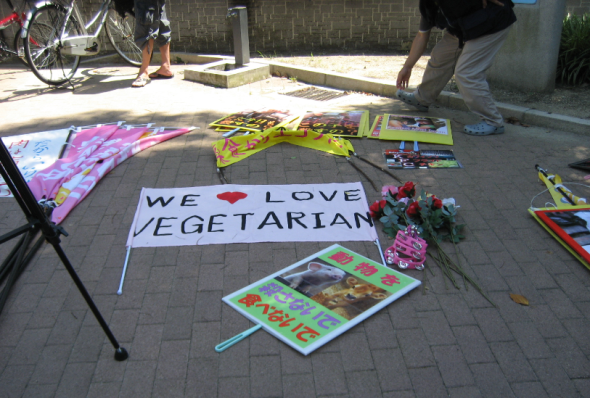
Harvey – Where have you been the most successful as an animal activist, for example, have you managed to change laws, have you changed the way a dog breeding farm works or have you stopped abuse in some other way?
Vivian – With Shiseido, the largest cosmetic company in Japan, which has stopped their Animal Testing (except for in China). JAVA started a negative boycott campaign to stop Shiseido’s Animal Testing in 2009. We conducted demonstration marches in front of Shiseido stockholder meetings in Tokyo and Osaka and asked stockholders to pressure the company to stop animal testing. JAVA also collected signatures through the Internet and a newspaper advertisement, and then handed over about 46,000 signatures to Shiseido. These activities were featured by the media , which attracted people’s attention the fact that animal cosmetic testing is a social problem in Japan. In March 2010, fter about a year after starting the campaign, Shiseido announced that they would begin an effort to abolish animal testing, and in Feb. 2013 they officially announced they would abolish animal testing for all their cosmetics (including materials and commissioning manufacturer) which they began two months later (except for China).
This was a huge victory for animals and for us. Many people’s voices moved the big mountain, Shiseido, and it proved that our movement and our activities were able to bear fruit.
Harvey – Vivian, what you and JAVA have accomplished is amazing and we thank you for so much for your dedication and hard work. People like you and those at JAVA show the world that the Asian community does care about animals.
So what has been your largest demonstration, why did you demonstrate and did it make a difference? I am asking why because it shows the animal welfare community outside of Japan how capable and passionate Asian activists are about making change.
Vivian – Our first demonstration against eating meat in Japan took place on July 18th, 2010 Sunday. This was the first demonstration against eating meat in Japan, and it played an important role in raising the awareness of the Japanese people.

Harvey – What are your thoughts about the fur and meat trade of dogs and cats?
Vivian – I am absolutely against the fur and meat trade of dogs and cats. Japanese people love dogs and cats, and most don’t know that dogs and cats are killed for fur and meat. I want them to know the truth. I think if the Japanese people knew the truth, they would be shocked and it would be an opportunity to think about those issues and stop them .
Harvey – Whenever Speak Up For the Voiceless.Org and many other animal and environmental organisations create awareness about the dog and cat meat and fur trade within Asia we receive such harsh racial slurs against Asians. The general public does not understand that those who do the abusing are only a minority and instead, they blame all Asian citizens. What are your thoughts on this and do you have a message to those people that brand all Asians as cruel to animals?
Vivian – I think the culture that eats dog and cat meat, as well as dolphin and whale, has to be criticized. However, in Asian countries, I guess many people think the culture is is comprised of elderly people and out of date - many don’t even know about the culture. I think if more people knew the facts they would see that this culture is wrong and not humane. I want those people who think all Asian people are cruel to know these things and that many people within Asia are also upset about this cruelty .
Harvey – When we document the cruel abuse that animals suffer within Asia we are met with comments such as, “boycott Asian products.” What are your thoughts about this and do you think it is fair for people to ask for this knowing that boycotts affect innocent Asian citizens and can potentially harm them economically?
Vivian – When we want to solve these problems, we have to consider doing more effective, productive and meaningful things and organize a plan. Products are produced because the consumer wants to buy them. I think if the consumer stops buying products made in countries that abuse animals or made from abused animals, the products will not be produced, so that can be effective, however, to boycott Asian or some other country’s products indiscriminately is not good or effective.
Harvey – Thank you for explaining that, Vivian. I do believe that if people boycotted products that are made from abused animals then this would be very beneficial . To boycott an entire country is not good or very effective and can have disastrous effects for many, even those who are actively fighting to stop abuse.
I see that you have been working on many issues such as anti-fur, anti-vivisection, no kill / adopting, vegetarian / anti meat-eating, animal welfare. Please describe what your role is with these projects and how influential you have been - have you made change happen, and if so, how did this make you and others feel?
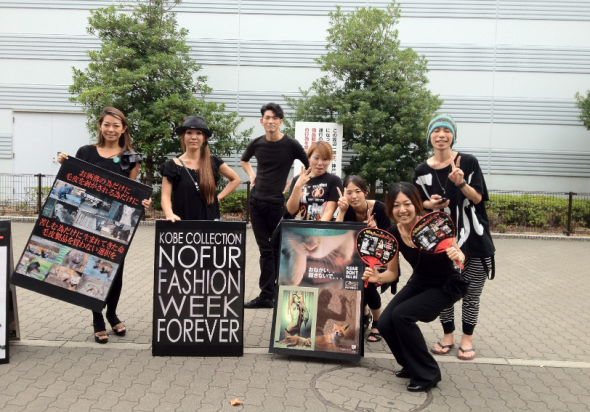
Vivian – I did succeed in spreading awareness through many actions and to many people through demo marches, panel exhibitions, leafleting, SNS, blog, BBS and so on. I’ve also appealed to many companies, administrations and governments etc. to save animals via stopping animal testing, killing dogs and cats, to making effective laws to protect animals and so on via telephone, fax, e-mail and mail, as well as offering information about living a cruel-free lifestyle by becoming vegan/vegetarian, boycotting products that use animal testing and promoting vegan products. One of our most successful actions was Shiseido’s Stop Animal Testing boycott campaign. I think it is most important to spread facts and awareness but also the facts on what and how to do even one little thing to help animals. Over the several years my fellow activists and friends have beenspreading these facts awareness I received so many reactions such as, “I was shocked I became a vegan/vegetarian,” or, “I didn’t know these facts, thank you for telling me,” or, “I will start doing something to help animals, like you,” or, “I want to join in your activities because I want to be voice of animals”. All of these comments encourage me and make me feel glad I have been doing these things . We have to continue widening the circle of awareness.
Harvey – Vivisection is an appalling act of animal abuse. What is your message to the European and American vivisectionists that take animals from Asia to use and barbarically torture?
Vivian – Honestly, I want them to stop every vivisection now since they are meaningless and wrong from the point of view of ethics and science and for people and animals. Also, the transportation of these animals, which places them in very stressful conditions for long periods of time, is unacceptable. Harvey – Your demonstrations in Japan look very effective and colourful Many activists across the globe often have issues with police suppression. . What are your thoughts on this and have you or a friend ever experienced police brutality?
Vivian – In my area most policemen are polite and good to us, as well as cooperative, as we are, so I have never felt bad around them. Some of them have actually praised our activities and our demonstrations .
Harvey – Vivian are you a vegetarian or vegan? What made you turn to (either) and why?
Vivian – I’m a strict vegan because I want to help animals and don’t want to eat them. Many animals will not be produced and killed if I stop eating or using animals. I stopped eating meat and became a vegan once I become aware of animal abuse and understood that many animal rights activists are vegan / vegetarian. I think veganism is a non-violent lifestyle, and to become vegan is just a starting point for me. For animals, environments, people and our earth, we can do many more and very simple things to put a brake on this mass production / consumption / destruction economy. We need to popularize being vegan.
Harvey – The Sea Shepherd Conservation Society have been actively making great progress against the whaling business by lowering kill rates and highlighting abuse. However, SSCS has come under great fire from the Japanese and other governments for its effective non-violent campaign. What is your position on the whaling business, do you believe that Japan must stop whaling to protect future marine conservation sites and mammals and what are your thoughts on the consumption of whale meat and why the Japanese culture should end it?
Vivian – I think Japan must stop whaling now for the conservation of the environment and the animals. Whaling is continued due to our taxes for political concessions and earns copious profits for only few people. There is actually a surplus on many whale meats, whichcauses low demand, so it is unnecessary.
Harvey – The International Animal Rescue Foundation has been actively fighting against the use of rhinoceros horn as pseudo medicine in the traditional Chinese medicine trade. . Rhinoceros in Asia and India are brutally slain for their horns, which are hacked off to feed this repulsive trade in Asia. What are your thoughts on this and do you have a message to say to the Asian and non-Asian Rhino horn medicine-using community?
Vivian – Hunting rhinoceros is so cruel and this abuse should never be accepted - we must stop it soon. Humands need to stop using animals for their own selfish desires.
Harvey – Every 15 minutes an elephant is barbarically killed in Africa just to provide ivory, better known as white gold. We are losing a staggering 35,000+ elephants a year due to the fact that many Asian individuals believe that the elephants tusk can be removed without killing the animal . What are your thoughts on this and have you demonstrated against the use of rhino and ivory parts, as well as the poaching of these two mammals?
Vivian – This is also horrible - hunting rhinoceros and elephant must stop now. A lot of substitutes already exist, so there is no reason to use real ivory. I have signed some petitions and spread these facts throughout the Internet to help stop this abuse.
Harvey – Millions of dogs and cats are left homeless every year internationally and locally within Japan because of animal neglect and abuse. What work have you done to promote a no-kill policy and the adopt, don’t shop philosophy?
Vivian – It’s so shameful that we have not stopped this kind of slaughter in our own country. The number of animals abandoned at (animal shelters) is still big. Most of them are unwanted kittens, so we have also promote sterilization http://ejje.weblio.jp/content/sterilization and castration operations to help control the unwanted cat population. Also, to stop killing animals, we have to abolish the commercial pet industry. I have been involved in many educational actions such as demonstration marches, leafleting, panel exhibitions and Internet awareness spreading as well as posting our demands to stop the needless killing of animals. Additionally, I have visited administrative facilities (animal shelters) that have many animals and kill animals and had meetings with those in charge. The Law of Humane Treatment and Management of Animals of Japan were revised slightly in 2013, but it is not strong enough and has not been used efficiently yet. We have to continue our educational activities, and make many more people understand why they should choose to adopt, not shop.

Harvey – That’s amazing, Vivian - your contributions and hard work are breathtaking. You really do show such love and compassion and possess such a strong voice for stray animals within your country and others. Well done!
I would like to take this opportunity in thanking you, Vivian, for answering my questions and to thank your fellow activists at JAVA for such outstanding work and achievements. It really goes to show that the Asian community does care, hates animal abuse and that there are only a minority of people that actually do kill and abuse animals. Knowing that few people within Japan are actually aware of such abusive regimes can only inspire us to promote and support all Asian activists and create more awareness about their works.
“ “My aim is not only to stop animal abuse but also to change our current mass production, consumption, destruction economy,” says Vivian. “I will fight to end the suffering of animals until the end of my life.”
Now who can say that all Asian citizens are animal abusers who will kill anything? International Animal Rescue Foundation and Speak Up For the Voiceless actively supports many Asian activists whose work to reduce animal cruelty and change laws to protect animal welfare we will continue to highlight. Vivian is a young, passionateactivist that has committed her life to animal welfare - we can’t thank her and comrades enough for working so hard to create such positive change for animals in their country .

